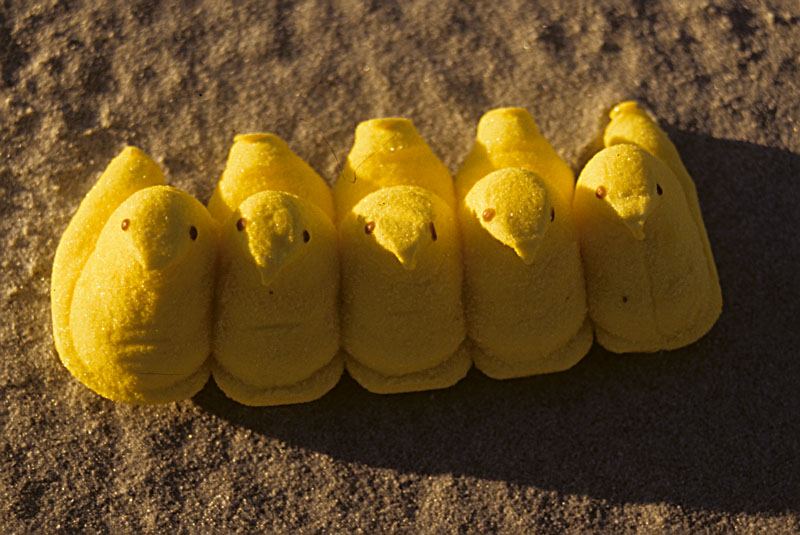Once a year, around Easter time, an attentive beachcomber might notice the unusual traces of a migratory animal on the sands of the Georgia barrier islands. Based on a few clues, its traces point toward five identically sized and conjoined tracemakers, indicating some sort of obligatory group behavior.
Eyewitnesses swear these tracemakers – nicknamed “peeps” – possess a few superficial avian qualities, yet they lack many of the anatomical traits we normally associate with birds, such as, well, wings and legs. Indeed, they apparently have flat ventral surfaces, which with their forward movement along beach sands cause trails, rather than trackways.
 Peep trail, observed on berm of Nannygoat Beach, Sapelo Island, Georgia. Oddly enough, this trail shows both a sudden start and end, almost as if the peeps were placed and removed from the surface, respectively.
Peep trail, observed on berm of Nannygoat Beach, Sapelo Island, Georgia. Oddly enough, this trail shows both a sudden start and end, almost as if the peeps were placed and removed from the surface, respectively.
As a result, peep trails – which are sometimes sinuous, but always harmonious – consist of five parallel grooves, each spaced equally and separated by six ridges, four on the interior of the trail and one on each side. Lateral movements along the length of a peep trail can vary the height of these ridges, depending on whether the peeps are banking to the right or left as they turn.
Although flying ability in peeps has only been inferred on the basis of their possible avian affinity, peep traces show only very brief periods of airborne activity. These traces indicate a somewhat clumsy strategy when approaching ground surfaces, culminating in abrupt vertical descents best described to laypeople as “crashing.” Ideally, all five peeps leave impressions of their cranial anatomy, which includes rudimentary beaks and foreshortened premaxillas. I have no idea if this facial configuration reflects acquired characteristics – caused by frequent crashes – or are more attributable to their original genotype.
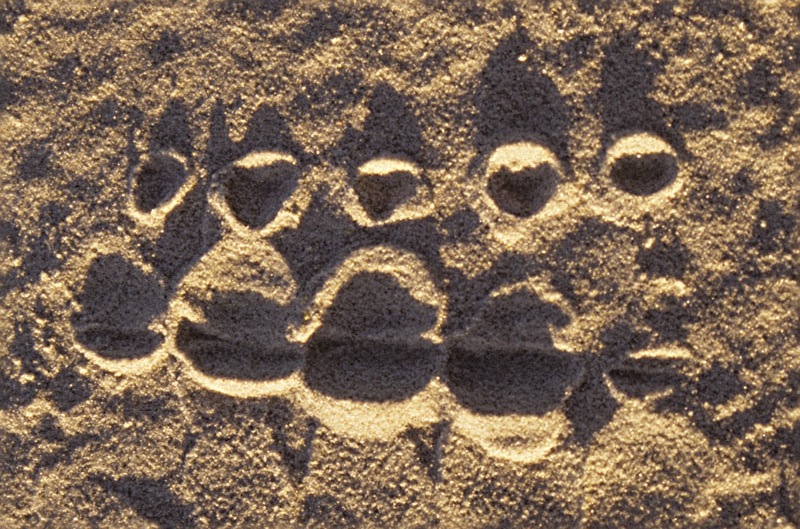 Peep landing trace, in which impressions of the anterior anatomy are preserved. Note the short beak marks and rounded dorsal portion of the torso, but with a thin shelf close to the ventral surface. Sand ridges around the impressions suggest the tracemaker bounced after landing.
Peep landing trace, in which impressions of the anterior anatomy are preserved. Note the short beak marks and rounded dorsal portion of the torso, but with a thin shelf close to the ventral surface. Sand ridges around the impressions suggest the tracemaker bounced after landing.
Peep resting traces are sometimes subtle, owing to their light weight, which according to some sources is about 85 grams (3.0 ounces) in total, or 17 grams per peep. In such instances where their resting traces are recognized, though, peep ventral anatomy is more clearly discernible. Interestingly, the anterior portion of their bodies is rounded and broad, but tapers into a blunt, narrow posterior with a possible upturned tail, the latter suggested by a thin groove bisecting the dorsal part of this posterior mark.
But perhaps the puzzling aspect of these traces is their lack of feather impressions. This evidence shows that peeps, despite their inferred avian affinity, must have become secondarily featherless, despite a long history of descent from non-avian dinosaurs.
 Peep resting trace, barely noticeable owing to the light weight of its tracemakers, yet still apparent through its typical overall five-part form.
Peep resting trace, barely noticeable owing to the light weight of its tracemakers, yet still apparent through its typical overall five-part form.
As is typical with resting traces, these are often connected directly to traces of other behaviors, such as locomotion or burrowing. Indeed, peep resting traces sometimes segue into or out of shallow burrows, which again have five impressions on their bases. Burrowing is presumably an adaptive strategy to avoid predation, implying delectable qualities.
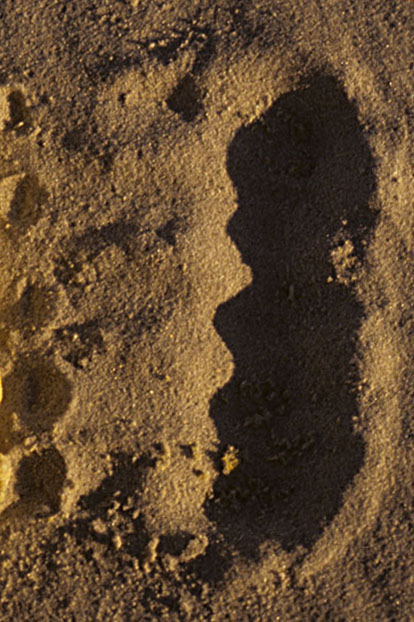 A peep resting trace that is also a burrow, and connecting to an exit mark (right) in which the peep tails left impressions with movement up and out of the excavation.
A peep resting trace that is also a burrow, and connecting to an exit mark (right) in which the peep tails left impressions with movement up and out of the excavation.
Peeps are rarely sighted outside of small, cellophane-wrapped boxes in urban shopping centers. Nevertheless, one spring I was lucky enough to see a gaggle of them (five, of course), exuberantly unbound. on a beach of Sapelo Island, Georgia. Thus I was able to observe them making trails, landing traces, resting traces, and actively burrow just above the intertidal zone, which may very well be their natural habitat.
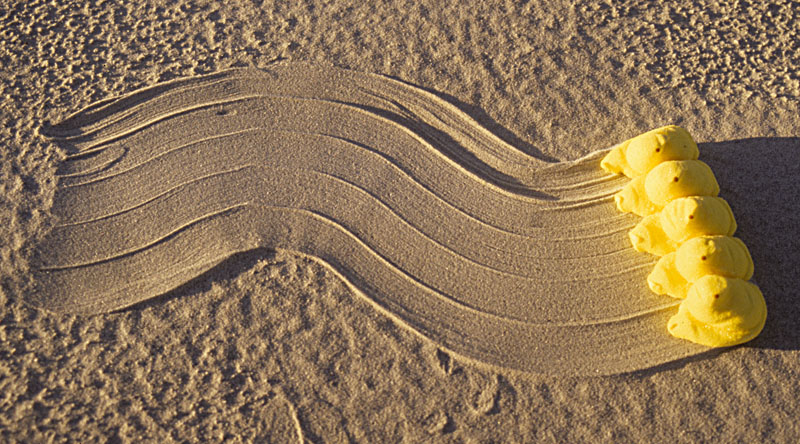 Five peeps making a trail as conjoined unit on a Sapelo Island beach, a behavior predicted by their traces. Who says ichnology isn’t a real science?
Five peeps making a trail as conjoined unit on a Sapelo Island beach, a behavior predicted by their traces. Who says ichnology isn’t a real science?
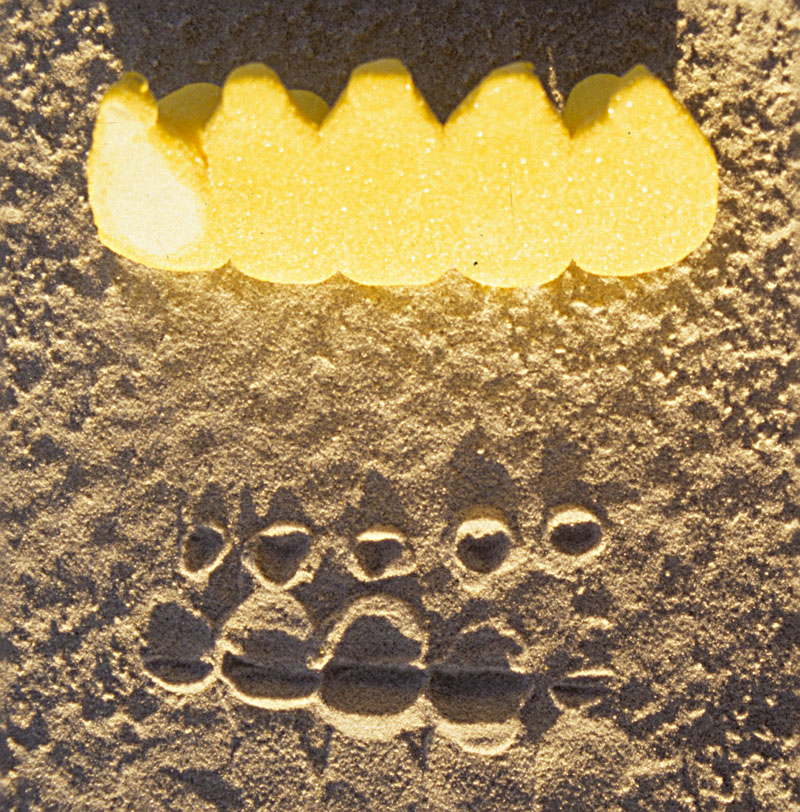 Peep landing marks from a short aerial excursion, with the peep presence a short distance away also supporting the interpretation of their bouncing forward after landing.
Peep landing marks from a short aerial excursion, with the peep presence a short distance away also supporting the interpretation of their bouncing forward after landing.
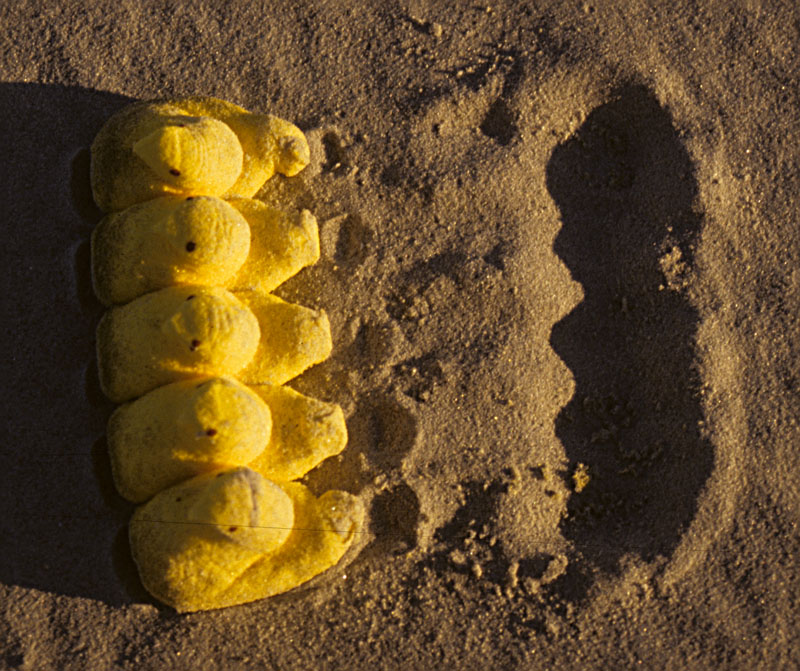 Peeps exiting a shallow burrow that was also a resting trace, a blend of behaviors often implied by traces.
Peeps exiting a shallow burrow that was also a resting trace, a blend of behaviors often implied by traces.
 Peeps initiating a deeper burrowing strategy, perhaps as a form of predation avoidance. Note how the trail becomes shortened, straight, and produces a large pile of sand in front of the direction of movement.
Peeps initiating a deeper burrowing strategy, perhaps as a form of predation avoidance. Note how the trail becomes shortened, straight, and produces a large pile of sand in front of the direction of movement.
 Never-before-seen evidence of how these legless peeps burrow! They use a combination of minute lateral undulations and forward movement directed downward at a shallow angle. As a result, the trail entering the burrow becomes covered by sand ridges produced by the subsequent behavior.
Never-before-seen evidence of how these legless peeps burrow! They use a combination of minute lateral undulations and forward movement directed downward at a shallow angle. As a result, the trail entering the burrow becomes covered by sand ridges produced by the subsequent behavior.
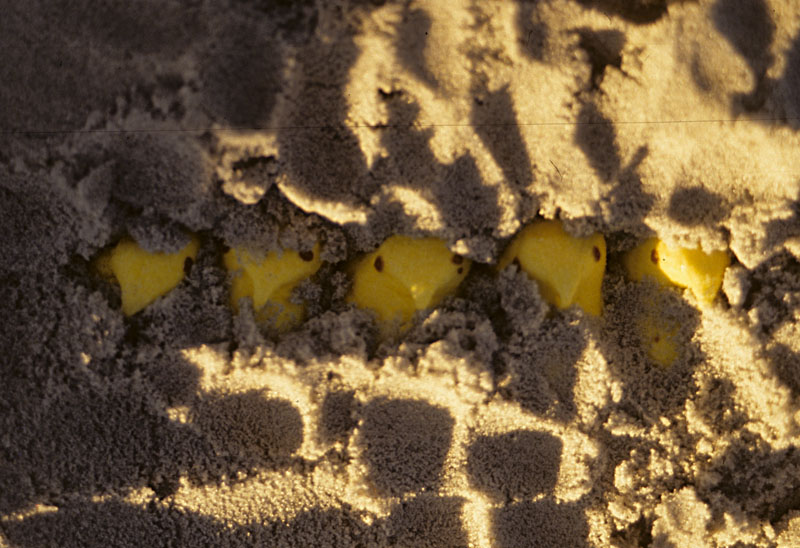 Success! These peeps have managed to bury themselves, leaving only a small portion of their heads exposed, with all five watching warily for predators,
Success! These peeps have managed to bury themselves, leaving only a small portion of their heads exposed, with all five watching warily for predators,
Peeps have been the subject of intensive research, but much of this work, however valuable, has been laboratory based and highly experimental. Thus the data I’ve presented here on their traces should greatly expand our understanding of their behavior in the context of natural settings. Further insights on the biology of peeps are currently murky, but their traces hold promise of fitting them into a taxonomic category more precise than “looks like little chicks.”
Although trace fossils of peep trails, landing traces, resting traces, and burrows have not yet been discovered, I propose these should have the following ichnogenus and ichnospecies names: Peepichnus quinquecalles (= “Peep trace of five trails”). However, I anticipate some of my ichnological colleagues will want to split the ichnotaxonomy of peep traces on the basis of whether they were moving horizontally versus vertically (the peeps, not my colleagues) and other such nuances. Personally, I think they just need to relax, stop coming up with so many silly, unpronounceable names, and just enjoy the sweetness of these little tracemakers of the Georgia coast.

